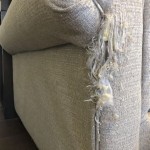How To Remove Pen Ink From a White Sofa
The pristine beauty of a white sofa can be instantly marred by an accidental pen ink stain. Whether it's a stray mark from a wandering hand, a leaky pen left on the cushion, or an artistic endeavor gone awry, ink stains on light-colored upholstery are a common household woe. However, the appearance of a stubborn ink blot does not necessarily signal the end of your sofa's spotless reign. A variety of techniques, utilizing common household items and commercially available cleaning agents, can effectively remove ink stains from white sofas.
The success of any ink removal method hinges on several factors, including the type of ink, the type of fabric, and the promptness of the action taken. Fresh ink stains are generally easier to address than older, set-in stains. Furthermore, different fabrics, such as cotton, linen, microfiber, or synthetic blends, will react differently to various cleaning agents. Before attempting any widespread cleaning, it is crucial to test the chosen method on an inconspicuous area of the sofa to ensure it does not cause discoloration or damage to the fabric.
The following methods offer a comprehensive guide to tackling ink stains on a white sofa, ranging from gentle approaches to more aggressive solutions when necessary. Remember to proceed with patience and caution, allowing ample time for each method to work and avoiding excessive scrubbing, which can further embed the ink into the fibers.
Key Point 1: Immediate Action and Blotting
The first step in mitigating an ink stain is immediate action. The longer the ink remains on the fabric, the more it will penetrate the fibers, making it significantly more difficult to remove. As soon as the stain is discovered, resist the urge to rub it. Rubbing will only spread the ink and force it deeper into the upholstery.
Instead, immediately grab a clean, white cloth or paper towel. Gently blot the stain from the outside edges inward. Blotting helps to lift the ink from the fabric rather than pushing it further in. Continue blotting with clean sections of the cloth until no more ink transfers onto the material. Avoid using colored cloths or paper towels, as the dye could potentially transfer onto the white sofa.
Applying a small amount of water to the cloth can sometimes aid in lifting the ink, but use it sparingly. Excessive water can potentially spread the stain or damage the fabric, especially if it is not treated immediately. After blotting with water, immediately blot again with a dry cloth to remove the excess moisture.
If the initial blotting removes a significant portion of the ink, proceed to more specific cleaning methods. If the stain persists after the initial blotting, the following techniques may prove more effective.
Key Point 2: Utilizing Household Cleaning Agents
Many common household items possess stain-removing properties that can be effectively employed against ink stains. These agents offer a less aggressive approach compared to commercial cleaners, making them a suitable starting point for delicate fabrics or minor stains.
Rubbing Alcohol (Isopropyl Alcohol): Rubbing alcohol is a frequently recommended solution for ink removal. Its solvent properties help to dissolve the ink and lift it from the fabric. To use rubbing alcohol, dampen a clean, white cloth with a small amount of alcohol. Gently blot the stain, working from the outside in. Avoid pouring alcohol directly onto the sofa, as this can saturate the fabric and potentially damage the underlying cushioning. As the ink transfers to the cloth, rotate to a clean section. Continue blotting until no more ink is visible. Once the stain is removed, blot the area with a clean, damp cloth to remove any alcohol residue. Finally, dry the area with a clean, dry cloth.
Hair Spray: Surprisingly, some hair sprays contain alcohol and other solvents that can help break down ink stains. Choose a hair spray that is not heavily scented or colored. Spray a small amount of hair spray directly onto the ink stain. Let it sit for a minute or two, and then blot the area with a clean, white cloth. The ink should transfer to the cloth. Repeat the process as needed. After the stain is removed, wipe the area with a damp cloth to remove any hair spray residue and dry thoroughly.
Hand Sanitizer: Similar to rubbing alcohol, hand sanitizer contains alcohol that can dissolve ink. Apply a small amount of hand sanitizer to the ink stain and let it sit for a few minutes. Blot the area with a clean, white cloth, working from the outside in. Repeat as needed, and then wipe the area with a damp cloth to remove any residue. Dry the area thoroughly.
Milk: Milk contains enzymes that can help break down certain types of ink. Soak a cotton ball or clean cloth in milk and gently dab the ink stain. Let it sit for approximately 30 minutes to an hour, allowing the milk's enzymes to work. Blot the area with a clean, damp cloth to remove the milk residue and dry thoroughly.
Baking Soda Paste: Baking soda is a mild abrasive and absorbent that can help lift ink stains. Mix baking soda with a small amount of water to form a paste. Apply the paste to the ink stain and let it dry completely. Once dry, vacuum the baking soda residue. If any stain remains, repeat the process. This method is best suited for durable fabrics, as the abrasive nature of baking soda may damage delicate materials.
White Vinegar Solution: A solution of white vinegar and water can also be effective. Mix equal parts white vinegar and water. Dampen a clean cloth with the solution and gently blot the ink stain. Let it sit for a few minutes, and then blot again with a clean, dry cloth. Repeat as needed. After the stain is removed, wipe the area with a clean, damp cloth to remove any vinegar residue and dry thoroughly. The odor of vinegar will dissipate over time.
Key Point 3: Commercial Stain Removers and Professional Cleaning
When household remedies fail to remove the ink stain, commercially available stain removers or professional cleaning services may be necessary. When selecting a commercial stain remover, ensure it is specifically designed for upholstery and is safe for the type of fabric on your sofa. Always test the product on an inconspicuous area before applying it to the stain.
Upholstery Stain Removers: Follow the manufacturer's instructions carefully when using upholstery stain removers. Generally, these products involve spraying or applying the solution to the stain, allowing it to sit for a specified period, and then blotting it away with a clean cloth. Be sure to remove any residue with a damp cloth and dry the area thoroughly.
Dry Cleaning Solvent: For stubborn ink stains, a dry cleaning solvent may be required. These solvents are powerful stain removers and should be used with caution. Wear gloves and work in a well-ventilated area. Apply a small amount of solvent to a clean cloth and gently blot the stain. Avoid saturating the fabric. Blot the area with a clean, dry cloth to remove the solvent residue. Allow the area to air dry completely. Dry cleaning solvents are not suitable for all fabrics, so always check the sofa's care label and test the solvent on an inconspicuous area first.
Professional Cleaning Services: For valuable or delicate sofas, or if the ink stain is particularly large or stubborn, it is best to consult a professional upholstery cleaning service. Professional cleaners have specialized equipment and expertise to safely and effectively remove stains without damaging the fabric.
When contacting a professional cleaner, provide detailed information about the type of fabric, the type of ink, and the age of the stain. This information will help them determine the most appropriate cleaning method. A professional can also offer advice on preventing future stains and maintaining the appearance of your sofa.
Regardless of the chosen method, patience and perseverance are essential. It may take multiple attempts to completely remove the ink stain. Between cleaning sessions, allow the fabric to dry completely. This will help prevent mold and mildew growth and allow you to assess the progress of the stain removal.
Ultimately, keeping a white sofa pristine requires vigilance and prompt action when spills or stains occur. By understanding the properties of various cleaning agents and employing the appropriate techniques, it is possible to effectively remove ink stains and maintain the beauty of your white sofa.

How To Remove Ink Stains On Leather Everyday Skate

How To Remove Pen Marks From Leather Sofa The Colour Doctor

How To Remove Ballpoint Ink Stain From Fabric Sofa

3 Ways To Remove An Ink Stain From A Couch Wikihow

How To Remove Ink From Leather Complete Guide

3 Ways To Remove An Ink Stain From A Couch Wikihow

How To Remove Ink From Leather 7 Proven Methods Manmadediy

Easiest Ways To Remove Ink From Leather Leatherneo

How To Get Ink Pen Stains Out Of A Sofa Stain Carpet

How To Get Pen Out Of Fabric Couch Sofa Ink Removal
Related Posts








